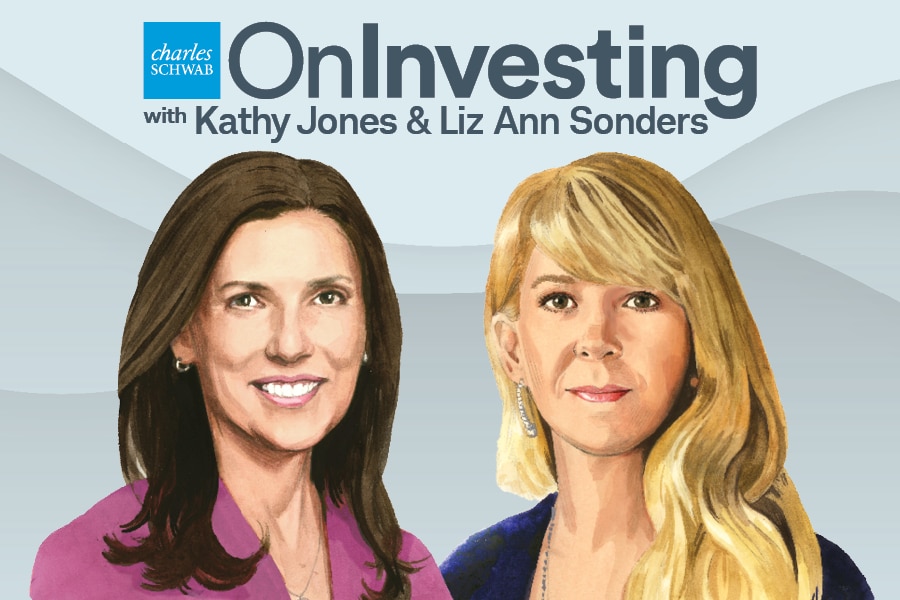How Will Tariffs & Debt Affect the Economy?

Transcript of the podcast:
KATHY JONES: I'm Kathy Jones.
LIZ ANN SONDERS: And I'm Liz Ann Sonders.
KATHY: And this is On Investing, an original podcast from Charles Schwab. Each week, we analyze what's happening in the markets and discuss how it might affect your investments.
Well, hi, Liz Ann. Maybe no surprise that we're still talking about tariffs and the trade war. But you want to give us a summary of where things stand, at least as of today?
LIZ ANN: Yeah, these days it's as of the past 30 minutes. I think the consensus right now, based on what I can pick up, is that we're right now running at about a mid-teens average effective tariff rate. And that's inclusive of the IEEEPA tariff staying on. And for those not in the know, IEEEPA stands for the International Emergency Economic Powers Act. There was the stay associated with the appeals decision after the trade court ruling that said they were illegal.
You know, we don't know what happens from here other than an assumption, certainly Mike Townsend's assumption, that this eventually go to the Supreme Court. So we're certainly not past any of the uncertainty. And I think we are finally starting to see it infiltrate some of the numbers. We've seen it in many of the regional Fed surveys in terms of pricing components, we saw it in the somewhat surprising release by Institute of Supply Management, the ISM non-manufacturing, which we generically call services.
That moved down into contraction territory, which was not expected, and that caught down to the manufacturing side, which has already been in contraction, but the prices-paid component continues to be spiking higher. So that particular reading had a bit of a stagflationary impulse to it, very much driven by tariffs. And I think we may be starting to see it work its way into some of the employment numbers, too. As you and I are taping this, we just got the release of initial unemployment claims, and they were up more than expected, layoff announcements up, so this is all very much tariff-related and I think there's probably more to come on that front.
Another thing that's very much in focus, obviously, is the budget bill that's working its way through the Senate right now. It's actually called the “One Big Beautiful Bill Act.” How much could this proposed bill add to the deficit and what could the potentially mean for the fixed income markets? There have been lots of estimates out there, including an update from the Congressional Budget Office saying that a lot of it will be paid for by tariff revenue. But to try to guess what tariff revenue is going to be in the next 10 years, that's what I'm having trouble with that assumption. But what are your thoughts?
KATHY: Oh yeah, I think it's very difficult to estimate what the tariff revenue is going to be between the fact that we don't know how long the tariffs will last. Those that are implemented so far and those that are proposed, we don't know how long those will last. Presumably this administration will be over in three and a half years and then there'll be a new administration and those could change, and it could change any moment, to tell you the truth since there's ongoing talks all the time.
So it is an assumption. And I think everybody who does this analysis is trying to work through some numbers, a range of numbers to have as assumptions. But between the CBO, or the Congressional Budget Office, and the Yale Budget Lab, which does a fabulous job on these numbers, it looks like it's going to add anywhere from $2.4 trillion to $4 trillion to the deficit over 10 years, depending on what assumptions you make. And that's a lot.
That's going to mean a lot of financing in the debt markets and the Treasury market. And we can see from just the various reactions in the markets when we get budget news, we can see the long end of the market, the longer maturity bonds kind of react with yields going up, while the shorter maturity are much more tied to Fed policy. So anything two years, even five years out is going to be a pretty close reflection of what the market assumes the Fed is going to do over the next couple of years. But when you get out further, this is more about supply and demand. And the number of buyers, the further out you go in maturity, the number of buyers narrows. Now, they're big buyers because their pension funds, insurance companies, super national organizations, et cetera, other governments to some extent.
So they're very large institutional buyers. You don't tend to have a lot of people interested in buying 20- or 30-year Treasuries. Maybe if yields get high enough, we will. But at this stage of the game, that's not usually who's really participating in the auctions, say. So there's going to be a lot of focus on that, on how we're going to finance this over time. I do want to, though, address, when it comes to this, one question I get a lot from people is, “Are we going to default on our debt? Or are we going to run out of money? Is this going to be an implosion of the Treasury market?” And I think that that kind of conclusion is really overblown. We are not going broke. We're the largest economy in the world. We're a very wealthy country. I always say this. We have the capacity to finance our debt. And I have no doubts that we will continue to finance our debt. But it puts, obviously, a strain on the budget to have so much going to interest payments rather than to other things. And you can see the battle that's going on. Some people want tax cuts. Other people want to maintain the amount of spending we have or increase it. And it's very hard to do when your largest expense, one of your largest expenses, is interest expense.
And we can't really count on yields coming down too much, particularly longer-term yields, because that is more controlled by supply and demand in the marketplace. And our biggest creditors, China and Japan, hold a lot of U.S. Treasuries. We're engaged in trade conflict with them right now. So it's kind of discouraging them from accumulating more. And they tend not to.. you know, other governments tend to hold maybe shorter to intermediate term. They don't tend to go out real long term anyway.
This is creating just this back and forth in the Treasury market that's just really, really leaving us all in this trading range and kind of swirling in a loop. And I think that that continues until we get data that says, “Yes, the economy's slowed down enough, or inflation's falling enough that the Fed's going to cut.” And as you say, we may be getting close to that. We're soft data on the employment side. That's going to be really crucial, the Fed dual mandate, full employment is part of the mandate, and maybe some softening inflation figures as well. So we still hold that, you know, the expectation that the Fed will cut in September and maybe one more time towards the end of the year, depending on how all this evolves. So we think the long-term outlook is still for yields to come down, but in the short term we could just bounce all over the place and a lot of it comes down to trade and budget.
And right now, those are hard to handicap. That's the very short version of my mid-year outlook that is publishing this week. We're publishing them early; don't hold us to it beyond next week. But it will…
LIZ ANN: Yeah, our mid-year outlooks might actually be stale before we get to the mid-year point.
KATHY: Mid-year, yes, exactly. But you you gotta do something, right? You gotta put yourself out there a little bit and give some guidance for our clients.
Now let’s look ahead to next week.
So, Liz Ann, big jobs report out on Friday. Everyone's going to be watching this one. What do you think of it and what else do you expect to be important for investors to keep an eye on?
LIZ ANN: I'm going to not try to forecast what the number is going to be because our podcast listeners will be listening to this episode after the numbers have been released. So, maybe I should do it and hope that I sound brilliant, but I'm more likely to miss the mark. I will say that, you know, there's often a whisper number when it comes to a jobs report. As you get closer, there's the consensus estimate, which I think is for the payroll number, 120, yeah, I think …
KATHY: I think it's around 125,000 or so. Yeah.
LIZ ANN: 130 as of right now. But the whisper number is lower. And I think that whisper got louder for a lower number when we got the unemployment claims release and continuing claims are again at a cycle high. So maybe, based on the whisper number coming down, the bar is set sufficiently low that we don't have that disappointment. But this is where the rubber meets the road. We've talked about this a lot. I think the labor market absolutely holds the key. It holds the key for the consumption side of the economy and to a larger degree, it holds the key for Fed policy because I think that's more the needle mover, the labor market side of their mandate in terms of justifying a move back toward cutting interest rates.
But it's also a big week next week because we get the Consumer Price Index, we get the Producer Price Index, and we get, I think it's initial reads out of the University of Michigan on consumer sentiment, shorter-term and longer-term inflation expectations, which is something that the Fed pays some attention to. So that's what's on my radar for next week. How about you?
KATHY: Yeah, I think the inflation numbers, obviously the key reports coming up and talking about inflation expectations. The New York Fed did an interesting study where they talked about whether tariffs are being passed along and indeed, they found that yes, they are by and large, as much as possible, they will be passed along. So, you know, we know there's a bump in prices coming. We just don't know when it will arrive and then we have to see if that's just a bump, a one-time bump or whether there's going to be something else. It's going to continue to be an issue. So, keeping an eye on those inflation expectations as well as the actual inflation numbers.
LIZ ANN: I had an interesting conversation at a client event yesterday about, not so much who pays the tariffs, that's what generated the question because I always remind groups that it's U.S. companies importing the goods that pay the tariff. But this gentleman said, “But isn't it the case that it's indirectly paid by the targeted country because they'll cut their prices of those goods to offset the tariff?”
I said, “Well, that's a lovely thought. It doesn't happen. It hasn't happened.” The U.S. company pays the tariff and then most of it, to your point, I saw that Fed study too, New York Fed study too, does get passed on to consumers. There's no major eating of it in profit margins, certainly not among retailers, which operate with very narrow profit margins. So I agree. I think this ultimately gets passed on to the consumer.
KATHY: Well, it's an interesting point because another thing people expect from tariffs is for the country imposing the tariffs to have their currency go up so that the importing country's currency is down to offset the tariffs. And actually, the opposite has happened. The U.S. dollar, when I look at it on a trade-weighted basis, meaning versus currencies of countries we import from, weighted by the quantity that we import, the dollar is near a three-year low right now. It has really come down since the introduction of those tariffs. So that is also an inflationary impulse for us and it also raises the cost. So it's not working, I think, as the textbooks would indicate for a variety of reasons, but something to keep an eye on, but it could actually add to the inflation pressure.
LIZ ANN: On that note, one other data point from this week that I think was interesting was the combination of labor costs and productivity. Labor costs were up a bit more than expected and productivity wasn't just lower than expected, it actually was in negative territory. That's not a great combination.
KATHY: Yeah, let's hope that gets revised away. The only thing I can say about productivity numbers…
LIZ ANN: They are very subject to revision, yes.
KATHY: Right, right. There's a lot of revisions that go into those. I saw the numbers and I thought, “Let's just hope that's not real and, you know, we'll get subsequent revisions.” But you know, speaking of revisions, there's one more point to make. The various government agencies that gather information are feeling the pinch from the cutbacks and we're not getting data gathered for CPI from certain metropolitan areas now. And similar story is going to be the case in the labor market. So we're actually getting less complete and potentially accurate data now because of these cutbacks at a time when we really, really need accurate data on prices and labor markets. So it's going to be another complicating factor.
LIZ ANN: Yep, good point.
KATHY: So that's it for us this week. Thanks for listening. As always, you can keep up with us in real time on social media. We both post regularly on X and LinkedIn. I'm @KathyJones. That's Kathy with a K, not spelled some sort of weird way by an imposter. And that's on X and LinkedIn.
LIZ ANN: And I'm @LizAnnSonders on X and LinkedIn. I'll reiterate what Kathy just said. If there's three Zs or an exclamation point or four dollar signs or the person you think you're following has 18 followers, it's not me. So make sure you're following the real us. And you can read all of our written reports, as Kathy said, her mid-year outlook publishes this week, mine publishes on June 9th, so next trading day following this posting and all of our written reports that are often filled with charts and graphs are at schwab.com slash learn.
And, of course, if you've enjoyed the show, we'd be so grateful if you'd leave us a review on Apple Podcasts or rating on Spotify or feedback wherever you listen. Also, maybe you'll tell a friend about the show. We'd love that.
We are going to be doing some traveling and taking some time off this summer, but we will be back next week with a new episode, so stay tuned.
KATHY: For important disclosures, see the show notes or visit schwab.com/OnInvesting where you can also find the transcript.
Follow the hosts on social media:
" id="body_disclosure--media_disclosure--167011" >Follow the hosts on social media:
In this week’s episode, Kathy Jones and Liz Ann Sonders discuss the current state of tariffs and the ongoing trade war, the implications of budget bills on the economy, and insights into inflation and the labor market. They explore how tariffs are affecting economic indicators, the challenges in estimating tariff revenue, and the potential impact of upcoming economic reports on Federal Reserve policy.
You can read Kathy’s midyear report, “Fixed Income Outlook: Cool and Cloudy” on Schwab.com.
On Investing is an original podcast from Charles Schwab.
If you enjoy the show, please leave a rating or review on Apple Podcasts.
About the authors

Liz Ann Sonders
